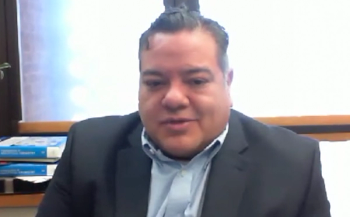
Claire Glynn Talks About Forensic Genealogy
In this video interview segment, Glynn of the University of New Haven discusses the significant advancements in forensic technology, particularly the use of forensic investigative genetic genealogy (FIGG) for identifying human remains.
The American Academy of Forensic Sciences (AAFS) Annual Scientific Meeting took place from February 17th to 22nd, 2025, in Baltimore, Maryland (1). During the week, conference attendees gathered at the Baltimore Convention Center to learn about the latest advancements in forensic science, which covered many different application areas. Once the conference concluded, we spoke with Tom Metz, a Laboratory Fellow and Chief Science Officer of the Biological Sciences Division at Pacific Northwest National Laboratory; Heidi Eldridge, a Certified Latent Print Examiner and the Director of Crime Scene Investigations at George Washington University; and Claire Glynn, a professor of forensic science and director of the Graduate Certificate in Forensic Genetic Genealogy, about what happened at the conference and what topics were extensively discussed throughout the week (1).
One of the topics discussed at AAFS was the advancements that have been made in forensic genealogy. Forensic genealogy integrates two disciplines, forensics and genealogy, and applies them to legal problems and proceedings (2). Forensic genealogy investigates family lineages using DNA analysis to build out a genealogical record and identify matches in DNA databases that are available (2).
In this video interview segment, Glynn of the University of New Haven discusses the significant advancements in forensic technology, particularly the use of forensic investigative genetic genealogy (FIGG) for identifying human remains. However, she also discusses other advancements in the field of forensic science, including the challenges posed by three-dimensional (3D) printed guns and the complexities of dealing with unidentified remains.
Glynn is a forensic scientist and educator specializing in forensic genetic genealogy (FGG) (3). She has been at the University of New Haven since 2014 and previously worked at Eurofins Forensic Services in the United Kingdom, focusing on forensic biology in homicide and sexual assault cases. With a Ph.D. in breast cancer research, she now applies molecular profiling to forensic science (3). Her research covers FGG applications, degraded samples, Rapid DNA, RNA analysis, and DNA methylation markers (3). Glynn also consults for law enforcement worldwide and has received multiple awards, including Connecticut Magazine’s “40 Under 40” in 2022 (3).
This interview segment with Glynn is part of our ongoing post-conference coverage of the AAFS Annual Scientific Meeting. To view all our recap coverage of AAFS, click
References
- Wetzel, W. What You Missed at AAFS. Spectroscopy. Available at:
https://www.spectroscopyonline.com/view/what-you-missed-at-aafs-2025 (accessed 2025-03-18). - Ramage, M. S.; Desmarais, C. B. W. Forensic Genealogy: Theory and Practice. National Genealogical Society. Available at:
https://www.ngsgenealogy.org/forensic-genealogy/#:~:text=Forensic%20genealogy%20is%20an%20emerging,Mineral%20Interests (accessed 2025-03-18). - University of New Haven, Claire L. Glynn, Ph.D. University of New Haven. Available at:
https://www.newhaven.edu/faculty-staff-profiles/claire-glynn.php (accessed 2025-03-18).
Newsletter
Get essential updates on the latest spectroscopy technologies, regulatory standards, and best practices—subscribe today to Spectroscopy.



